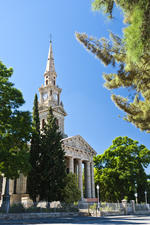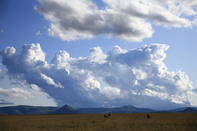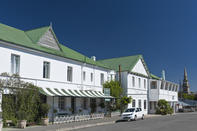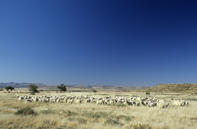Thriving Town
Cradock is a small and quaint town situated in the Great Fish River valley, and was founded by Sir John Cradock after the frontier war of 1812. Here, the soil is rich, the water plentiful and the weather pleasant and warm, making this little town an ideal lucern, dairy and fruit farming area.
Cradock has developed into a graceful town. Beautiful thatch and stone houses line the street, creating an atmosphere reminiscent of a bygone era. The Dutch Reformed Church is a definite must see, and this regal stone building has impressed guests from far and wide. Cradock is a thriving rural town, where farmers have utilized the indigenous flora of the area, such as Karoo bushes, as well as specialising in the production of wool and mohair.
Cradock boasts a pleasant climate, with hot and balmy summers and cold winters. The town also has a very low rainfall. Cradock is situated on the N10, almost halfway between Port Elizabeth and Colesberg. The nearest airport is at Port Elizabeth, 250 kilometres away.
Great Historical Past

Cradock is a cultural experience, especially for those interested in admiring the old buildings lining the streets. It is also a place with a great historical past. The Great Trek started in Cradock and its surrounding districts. The geographical location of Cradock makes it an excellent stopover for the weary traveler to rest his bones.
The town developed around the fort erected on the farm Buffelshoek in 1813 on the instructions of the British Governor, Sir John Cradock. It was officially named in honour of Cradock on 21 January 1814. One of the town's landmarks is the Dutch Reformed Mother Church, which was completed in 1868.
Built from local sandstone, the neoclassical church, with its Doric pillared portico and imposing steeple, is similar in design to the church of St Martin’s-in-the-fields in London. One of South Africa's greatest authors, Olive Schreiner, lived in Cradock between 1867 and 1870 in a flat-roofed cottage which has been turned into a museum devoted to her life. Her grave lies on Buffelskop to the south of the town, and can be reached along a 17-km drive.
Mountain Zebra National Park

The town is also home to the Mountain Zebra National Park. This national park offers great self guided hikes and the opportunity to view herds of Cape mountain zebra. It is a luscious and lovely park and boasts breathtaking scenery, as well as small herds of antelope, small predators and over 200 species of birds.
For panoramic views, take a drive up 'Oukop', which was used as a lookout post during the war. Enjoy a gentle walk around the slopes and view the Anglo-Boer war soldier's etchings on a rock. Another attraction is the sulphur hot springs on the western outskirts of the town.

